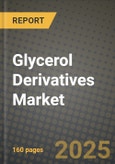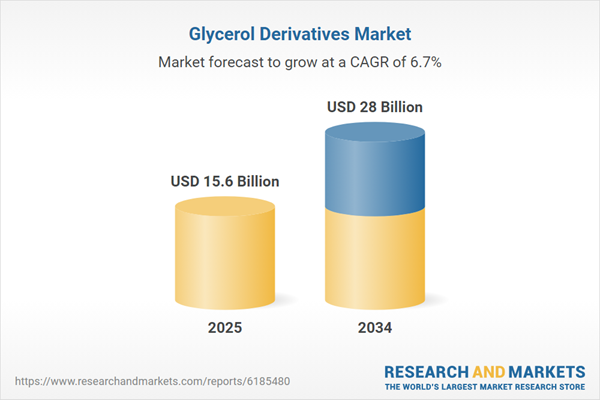Glycerol Derivatives Market Overview
The global glycerol derivatives market is witnessing consistent expansion, driven by its diverse industrial applications and rising demand for sustainable chemical alternatives. Glycerol, a byproduct of biodiesel production, serves as a crucial feedstock in creating value-added derivatives such as glycerol monostearate, glycerol carbonate, and epichlorohydrin. These compounds are extensively used across industries like pharmaceuticals, personal care, food & beverages, and polymer manufacturing. Growing awareness around green chemistry and the push for bio-based raw materials are encouraging manufacturers to invest in glycerol-based product innovation. In parallel, rising consumption of packaged food, cosmetics, and pharmaceutical formulations is sustaining the market's upward momentum. The surge in biodiesel production, especially in regions with supportive regulatory frameworks, continues to ensure steady glycerol supply, reinforcing the market’s raw material security. The glycerol derivatives market is thus evolving into a critical component of the global bioeconomy, with both established companies and startups tapping into its untapped potential.the glycerol derivatives market experienced notable transformation, particularly through increased integration of renewable resources and circular economy models in chemical production. Several manufacturers enhanced their refining capabilities to produce high-purity glycerol, which fueled downstream expansion of derivatives like glycerol diacetate and polyglycerols. Strategic collaborations and acquisitions played a key role in market consolidation, with companies aiming to broaden their product portfolios and geographical reach. Notably, Asia-Pacific emerged as a hotbed of production activity, thanks to cost-effective manufacturing and abundant raw materials. Innovations in personal care formulations, especially natural emulsifiers and moisturizers, elevated demand for glycerol esters. Additionally, the construction and automotive industries began leveraging epichlorohydrin derived from glycerol for eco-friendly epoxy resins. Regulatory bodies in Europe and North America introduced incentives for bio-based chemical production, further accelerating the commercialization of glycerol-based alternatives. These collective shifts established a more stable and innovation-driven landscape, preparing the market for sustained future growth.
The glycerol derivatives market is expected to gain traction from expanding applications in emerging sectors like biodegradable plastics, carbon capture, and pharmaceutical excipients. With the chemical industry undergoing a major sustainability overhaul, glycerol-based chemicals are poised to replace several petrochemical counterparts. Governments are anticipated to strengthen mandates favoring bio-based sourcing, which will encourage industrial-scale investment into glycerol refining technologies and derivative synthesis. Technological breakthroughs in enzymatic and catalytic processing are also projected to enhance yield efficiency and reduce production costs. As demand grows for multifunctional ingredients in cosmetics and food processing, glycerol esters and ethers are set to witness sharp demand spikes. Moreover, the integration of AI and process automation is expected to optimize supply chains, reduce waste, and improve overall market responsiveness. With rising investments in R&D and infrastructure, particularly in developing regions, the glycerol derivatives market is gearing up for a decade of dynamic transformation, shaped by sustainability, innovation, and global collaboration.
Key Insights: Glycerol Derivatives Market
- Growing demand for bio-based emulsifiers in cosmetics and personal care is propelling the use of glycerol esters, replacing synthetic counterparts for cleaner product labels.
- Wider use of glycerol-based epichlorohydrin in eco-friendly epoxy resins is expanding its role in green building materials and automotive composites.
- Expansion of biodiesel production is creating a surplus glycerol supply, encouraging low-cost feedstock availability for derivative manufacturers.
- Increasing adoption of polyglycerols in food emulsification is enhancing shelf-life and texture in processed foods, boosting market share in food-grade derivatives.
- Technological innovations in catalytic conversion processes are enabling high-efficiency production of high-purity glycerol derivatives, supporting cost competitiveness.
- Surging demand for natural and sustainable ingredients in cosmetics, food, and pharmaceuticals is pushing manufacturers to adopt glycerol-derived compounds.
- Government support and incentives for bio-based chemical production are encouraging industries to transition from petrochemical to glycerol-based alternatives.
- Rapid industrialization in Asia-Pacific and Latin America is expanding the production base and consumer demand for glycerol derivatives across sectors.
- Rising R&D investment in green chemistry and process optimization is improving scalability and application range of glycerol-based products.
- Fluctuating crude glycerol quality due to inconsistent biodiesel production standards can hinder the efficiency and uniformity of derivative synthesis, affecting product consistency.
Glycerol Derivatives Market Segmentation
By Product
- 4- (Hydroxymethyl)-1 3-Dioxolan-2-One
- Polyglycerol
- Propane-1 2 3-Triyl Triacetate
- 1 3 Propanediol
- Propylene Glycol
- Other Products
By Grade
- Bio-Based
- Petroleum-Based
By End-Use
- Food and Beverage
- Pharmaceuticals
- Cosmetics and Personal Care
- Construction
- Other End-Users
Key Companies Analysed
- Shell Plc
- Cargill Incorporated
- Archer Daniels Midland Company
- BASF SE
- The Procter & Gamble Company
- The Dow Chemical Company
- ThyssenKrupp AG
- Mitsubishi Chemical Corporation
- Saudi Basic Industries Corporation
- Merck KGaA
- Evonik Industries AG
- Solvay SA
- Sasol Limited
- Arkema SA
- Akzo Nobel N.V.
- Kerry Group plc
- Huntsman Corporation
- Lonza Group AG
- Nouryon
- Clariant AG
- Stepan Company
- Croda International Plc
- Tokyo Chemical Industry Co. Ltd.
- Sakamoto Yakuhin Kogyo Co. Ltd.
- Acuro Organics Limited
- Haihang Industry Co. Ltd.
Glycerol Derivatives Market Analytics
The report employs rigorous tools, including Porter’s Five Forces, value chain mapping, and scenario-based modeling, to assess supply-demand dynamics. Cross-sector influences from parent, derived, and substitute markets are evaluated to identify risks and opportunities. Trade and pricing analytics provide an up-to-date view of international flows, including leading exporters, importers, and regional price trends.Macroeconomic indicators, policy frameworks such as carbon pricing and energy security strategies, and evolving consumer behavior are considered in forecasting scenarios. Recent deal flows, partnerships, and technology innovations are incorporated to assess their impact on future market performance.
Glycerol Derivatives Market Competitive Intelligence
The competitive landscape is mapped through proprietary frameworks, profiling leading companies with details on business models, product portfolios, financial performance, and strategic initiatives. Key developments such as mergers & acquisitions, technology collaborations, investment inflows, and regional expansions are analyzed for their competitive impact. The report also identifies emerging players and innovative startups contributing to market disruption.Regional insights highlight the most promising investment destinations, regulatory landscapes, and evolving partnerships across energy and industrial corridors.
Countries Covered
- North America - Glycerol Derivatives market data and outlook to 2034
- United States
- Canada
- Mexico
- Europe - Glycerol Derivatives market data and outlook to 2034
- Germany
- United Kingdom
- France
- Italy
- Spain
- BeNeLux
- Russia
- Sweden
- Asia-Pacific - Glycerol Derivatives market data and outlook to 2034
- China
- Japan
- India
- South Korea
- Australia
- Indonesia
- Malaysia
- Vietnam
- Middle East and Africa - Glycerol Derivatives market data and outlook to 2034
- Saudi Arabia
- South Africa
- Iran
- UAE
- Egypt
- South and Central America - Glycerol Derivatives market data and outlook to 2034
- Brazil
- Argentina
- Chile
- Peru
Research Methodology
This study combines primary inputs from industry experts across the Glycerol Derivatives value chain with secondary data from associations, government publications, trade databases, and company disclosures. Proprietary modeling techniques, including data triangulation, statistical correlation, and scenario planning, are applied to deliver reliable market sizing and forecasting.Key Questions Addressed
- What is the current and forecast market size of the Glycerol Derivatives industry at global, regional, and country levels?
- Which types, applications, and technologies present the highest growth potential?
- How are supply chains adapting to geopolitical and economic shocks?
- What role do policy frameworks, trade flows, and sustainability targets play in shaping demand?
- Who are the leading players, and how are their strategies evolving in the face of global uncertainty?
- Which regional “hotspots” and customer segments will outpace the market, and what go-to-market and partnership models best support entry and expansion?
- Where are the most investable opportunities - across technology roadmaps, sustainability-linked innovation, and M&A - and what is the best segment to invest over the next 3-5 years?
Your Key Takeaways from the Glycerol Derivatives Market Report
- Global Glycerol Derivatives market size and growth projections (CAGR), 2024-2034
- Impact of Russia-Ukraine, Israel-Palestine, and Hamas conflicts on Glycerol Derivatives trade, costs, and supply chains
- Glycerol Derivatives market size, share, and outlook across 5 regions and 27 countries, 2023-2034
- Glycerol Derivatives market size, CAGR, and market share of key products, applications, and end-user verticals, 2023-2034
- Short- and long-term Glycerol Derivatives market trends, drivers, restraints, and opportunities
- Porter’s Five Forces analysis, technological developments, and Glycerol Derivatives supply chain analysis
- Glycerol Derivatives trade analysis, Glycerol Derivatives market price analysis, and Glycerol Derivatives supply/demand dynamics
- Profiles of 5 leading companies - overview, key strategies, financials, and products
- Latest Glycerol Derivatives market news and developments
Additional Support
With the purchase of this report, you will receive:- An updated PDF report and an MS Excel data workbook containing all market tables and figures for easy analysis.
- 7-day post-sale analyst support for clarifications and in-scope supplementary data, ensuring the deliverable aligns precisely with your requirements.
- Complimentary report update to incorporate the latest available data and the impact of recent market developments.
This product will be delivered within 1-3 business days.
Table of Contents
Companies Mentioned
- Shell PLC
- Cargill Incorporated
- Archer Daniels Midland Company
- BASF SE
- The Procter & Gamble Company
- The Dow Chemical Company
- ThyssenKrupp AG
- Mitsubishi Chemical Corporation
- Saudi Basic Industries Corporation
- Merck KGaA
- Evonik Industries AG
- Solvay SA
- Sasol Limited
- Arkema SA
- Akzo Nobel N.V.
- Kerry Group PLC
- Huntsman Corporation
- Lonza Group AG
- Nouryon
- Clariant AG
- Stepan Company
- Croda International PLC
- Tokyo Chemical Industry Co. Ltd.
- Sakamoto Yakuhin Kogyo Co. Ltd.
- Acuro Organics Limited
- Haihang Industry Co. Ltd.
Table Information
| Report Attribute | Details |
|---|---|
| No. of Pages | 160 |
| Published | October 2025 |
| Forecast Period | 2025 - 2034 |
| Estimated Market Value ( USD | $ 15.6 Billion |
| Forecasted Market Value ( USD | $ 28 Billion |
| Compound Annual Growth Rate | 6.7% |
| Regions Covered | Global |
| No. of Companies Mentioned | 26 |









